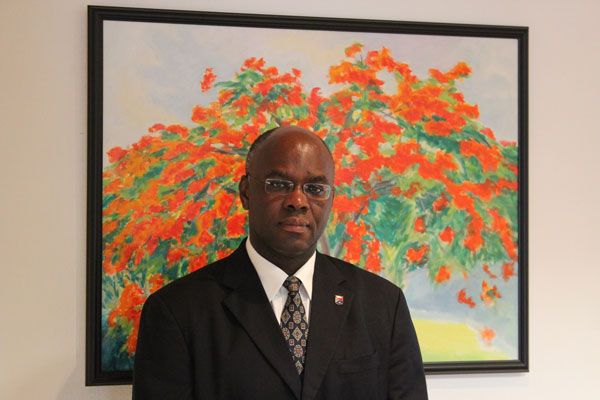by
His Excellency drs. E.B. Holiday
Governor of Sint Maarten
Delivered on the Occasion of the Observance of the
156th anniversary of Emancipation Day
 July 1, 2019
July 1, 2019
Emilio Wilson Estate,
Cul-De-Sac, Sint Maarten
My Fellow Sint Maarteners,
Good afternoon,
Marie-Louise and I wish you a most Blessed Emancipation Day,
We bring you greetings in honor of the sacrifices and triumph of our forefathers.
Emancipation is one of the most significant events in Sint Maarten’s history. Emancipation marked the triumph of the indomitable will of the enslaved men and women of Sint Maarten to be free. A triumph, which redefined our collective destiny as a Sint Maarten people.
My fellow Sint Maarteners,
Emancipation had a profound impact on perceptions, notions, and traditions and helped to reshape the social, economic, political and cultural order of Sint Maarten. We the people of Sint Maarten, the sons, and daughters of former slaves and slave-owners, have since realized major achievements, made possible by our collective efforts.
In doing so we created our Sint Maarten Culture. When we speak about culture, we are in fact speaking about identity. In speaking about identity, we are speaking about who we are as individuals and as a people. In speaking about identity, the best place to start is with our individual names. Our name is our identity, it is a window to our culture and to who we are as individuals and as a people. Our name connects us to our past and our past teaches us lessons for our future.
This fore day morning I mentioned the names of some of my pre-emancipation ancestors, such as, Couba and Present, which seems to point to their West-African origin and heritage. These names, which refer to the day of birth and the circumstance of birth, suggest that our ancestors, in resistance to the renaming practices of slavery, tried to maintain their customs, traditions, and culture of their forefathers. Other names of my pre emancipation ancestors include Francis and Madellaine, reflecting a break with their African naming traditions. That in keeping with the times they lived in. In recalling their names, I emphasized that we must identify, name, tell the stories of and as a result to connect with the men and women of Sint Maarten’s Emancipation Movement.
In doing so I was guided by the belief that the common future of our country, of our people, is grounded in our connection, knowledge, and understanding of our past. A glance into our past invariably reveals who we are today. How we got here, the land we live on, the structures that surround us, the foods we eat, the music we play, the way we speak and the very genes we carry have been inherited. In short, we are all carriers of the heritage and culture passed on to us by previous generations.
As carriers of the heritage of our ancestors, that is of their stories of struggle, sacrifice, and emancipation, we are reminded that we have a collective obligation to our forefathers to protect and continue to build on their legacy. That is a legacy to stand for, protect and build a culture of freedom, equality, justice, and brotherhood for the improvement of future generations. To fulfill our collective obligation, we must continue to build Sint Maarten based on the dignity and values of the individual, and on the entitlement of all individuals to fundamental rights and freedoms; that is we must continue to build our nation to secure jobs for our youth, eliminate poverty, and eradicate all forms of exploitation and oppression; that is we must focus on what we have in common as opposed to on our differences; that is we must work together if Sint Maarten is to prosper; that is we must unite as one people for our common cause: Sint Maarten.
Standing for and protecting Sint Maarten’s Cultural heritage is important. Important because our cultural legacy determines our destiny and our means to success. Important because the reason for Sint Maarten’s achievements over the years lies in its heritage, that is its natural beauty, our traditions, our history of courage, determination and resilience. A heritage that molded us into an island of resilient and friendly people.
Thanks to our heritage we have a rich Sint Maarten culture manifested in our food, drinks, music, and dance. A cultural heritage preserved through the works of various cultural pioneers such as: Tanny and the Boys with String Music, the York Family with music through the steel pan, Lasana Sekou with National Symbols as well as with poetry about salt, Ruby Bute with her Market Paintings, Roland Richardson with his paintings of the flamboyant tree, Clara Reyes with the Ponam dance and others with our national drink, Guavaberry.
My fellow Sint Maarteners,
As I said, as carriers of the heritage of our ancestors, we have a collective obligation to our forefathers to protect and continue to build on their legacy.
I am in that regard encouraged by the efforts of government and various persons in our society to preserve, nurture and build on our cultural heritage. I therefore applaud the work of Voices and its leader Ms. N-ko-sa-sana Illis through the annual observance of Emancipation Day towards the preservation of our culture. I am particularly pleased, given the importance of national heritage as a unifying force and as a critical driver of the development of our nation.
I good Friendly Sint Maarten tradition I therefore close and hereby, also on behalf of Marie Louise, wish you a most wonderful and memorable 156th Emancipation Day celebration.
Thank you,
God Bless you, and
May God Bless Sint Maarten and Protect its coast.
A Tribute To Our Forefathers
by
His Excellency drs. E.B. Holiday
Governor of Sint Maarten
Delivered on the Occasion of the Observance of the
156th anniversary of Emancipation Day
July 1, 2019
Diamond Hill, Sint Maarten
My Fellow Sint Maarteners,
Good morning,
Marie- Louise and I are honored to join and greet you on this Emancipation Day, at this historic location, in honor of the names of our forefathers.
Reflecting on the reenactment of the “Diamond 26 Escape” which we just witnessed, I thought on the words of Martin Luther King Jr. About 100 years after emancipation in Sint Maarten and the United states Martin Luther King Jr. said and I quote: “Free at last. Free at last. Thank God Almighty, I’m Free at Last.” unquote.
But quickly thereafter the words of Nelson Mandela came to me. Some 130 years after emancipation in Sint Maarten, Nelson Mandela wrote and I quote: “I have walked that long road to freedom. …. But I can only rest for a moment, …… for my long walk is not ended.” Unquote.
On this July 1st fore day morning we gather to celebrate and reflect on the 156th Emancipation Day, thanks to the triumph of the Emancipation Movement of our forefathers. An emancipation triumph which, through the resulting freedoms, had a profound impact on perceptions, notions, and traditions and as a result reshaped our cultural, social, political and economic order. A reshaped order that formed the basis for a more unified Sint Maarten, based on the universal principles and rights of liberty, equality and justice.
To reflect on emancipation is thus our reflection on the “Emancipation Movement” of strong, courageous and determined men and women. It is our reflection on our forefathers, your families and my families, whose stories of struggle, triumph and societal impact, too often go untold or too often are marginalized. To correct that, we must identify, name, tell the stories of and as a result connect with the men and women of Sint Maarten’s Emancipation Movement.
Through our oral and written history, we know that our forefathers never accepted their forced bondage. We know that they did everything possible to secure their freedom at the risk of grave consequences. They planned, they refused to work, they negotiated, they fought, they paid, they ran away and they died to seize their freedom.
The sacrifices they made in their struggles for freedom are exemplified in “One Tete Loke”, one of our Emancipation Movement heroes. Like her, many of our forefathers ran away into the hills or across the seas. With the abolition of slavery in the British islands as of 1834 and in the French Islands as of 1848 the number of escapes from plantations increased further, first to for example Anguilla and St. Kitts and latter to French Saint Martin.
On May 29, 1848, just one day after the abolition of slavery on the French side, 26 of our courageous forefathers who were enslaved on the Diamond Estate, decided to run for freedom across the border to the French side. This fore day morning reenactment of the “Diamond 26 Escape” places us back at the heart of the struggles of the Emancipation Movement. The historic Diamond 26 Escape helped to trigger widespread protests and as a result a breakdown of the system of slavery on Sint Maarten. It is for example documented that men and women of several estates of Dutch Cul-De-Sac refused to work and took to the streets in protest, as a result of the Diamond 26 Escape.
This history of resistance always causes me to reflect on the lives, courage and resilience of my Cul-De-Sac ancestors who lived around 1848. My ancestors such as Adella, my oldest known ancestor born around 1790, Couba Richardson, Francis Scott, Maddelaine Shiddling, Present Richardson, Walter Scott, William Gerot and Amanda Cocks, to name a few. All of whom were born before emancipation in the North and the South of our island.
My Fellow Sint Maarteners,
The Diamond 26 Escape, by triggering widespread protest, played a significant role in the emancipation proclamation of July 1st, 1863, which we celebrate today.
These historic reflections remind us that our forefathers had the will to be free, as well as the determination, courage and the acumen to secure it. It tells us that there was no mood among our enslaved forefathers to wait for their freedom or to accept the injustices they lived through. It tells us that they took the initiative and seized every opportunity to secure their freedom and to build a better future.
As we stand on these historic grounds and reflect on the legacy of emancipation we are reminded, that we – collectively – are indebted to our forefathers to protect and continue to build on their legacy. To fulfill our collective obligation, we must continue to build Sint Maarten based on the dignity and values of the individual, and on the entitlement of all individuals to the fundamental rights and freedoms; that is we must continue to build our nation to secure jobs for our youth, eliminate poverty, and eradicate all forms of exploitation and oppression; that is we must focus on what we have in common as opposed to on our differences; that is we must work together if Sint Maarten is to prosper; that is we must unite as one people for our common cause: Sint Maarten.
My fellow Sint Maarteners,
In conclusion, the best way to honor our forefathers is to actively fulfill our collective obligation. And to remind us of our collective responsibility let us memorialize and always remember, this historic diamond hill, as a beacon for freedom and a better future for all.
With that reflection on our collective obligation and responsibility as a result of Sint Maarten’s Emancipation Movement, I hereby, also on behalf of Marie Louise, wish you a most wonderful and memorable 156th Emancipation Day celebration.
Thank you,
God Bless you, and
May God Bless Sint Maarten and Protect its coast.









